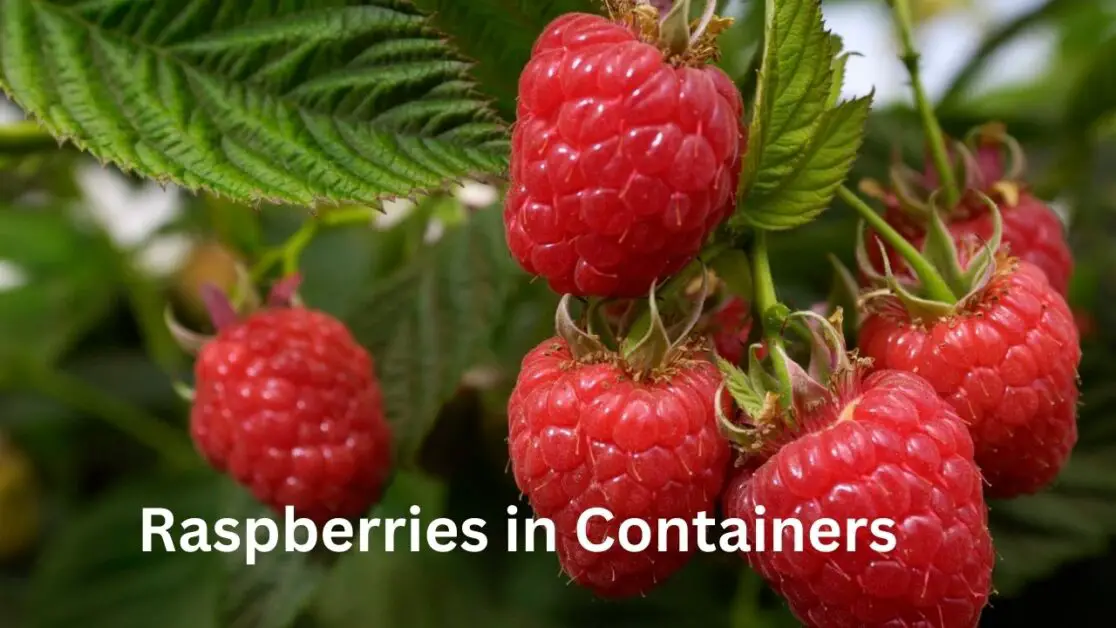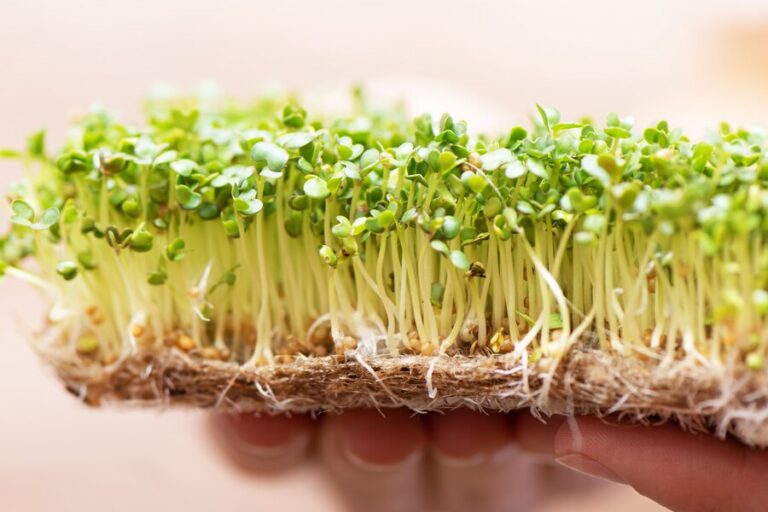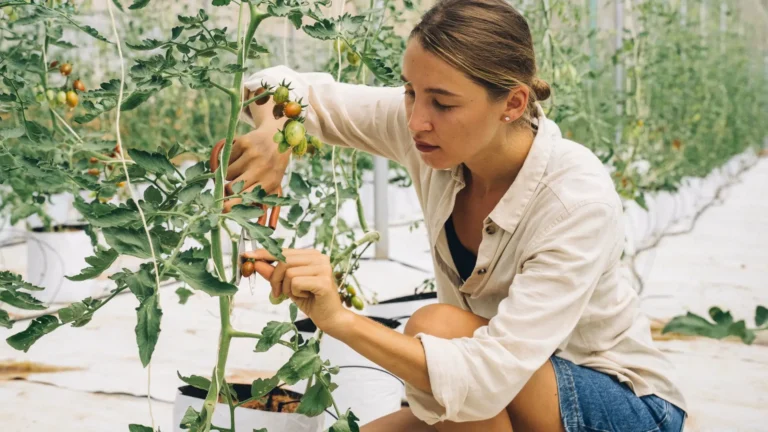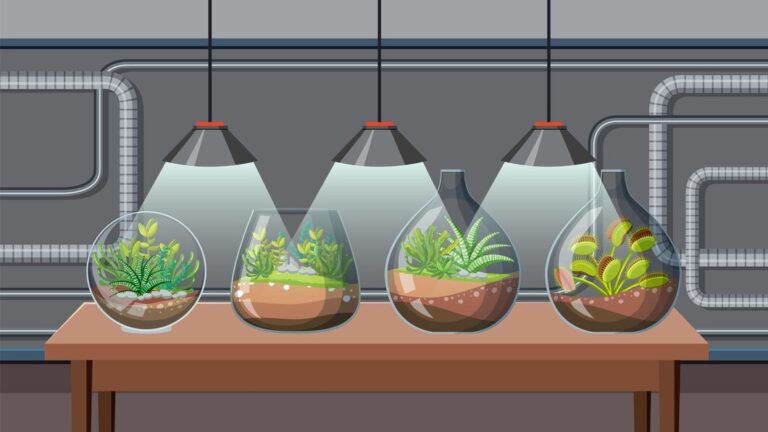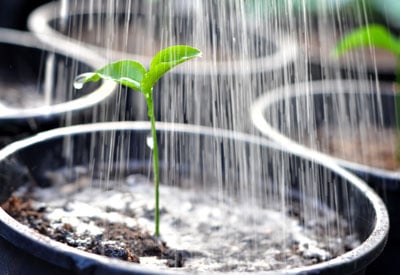The Best Way to Grow Raspberries in Containers Successfully
Table of Contents: Raspberries in Containers
Troub: Raspberries in Containers
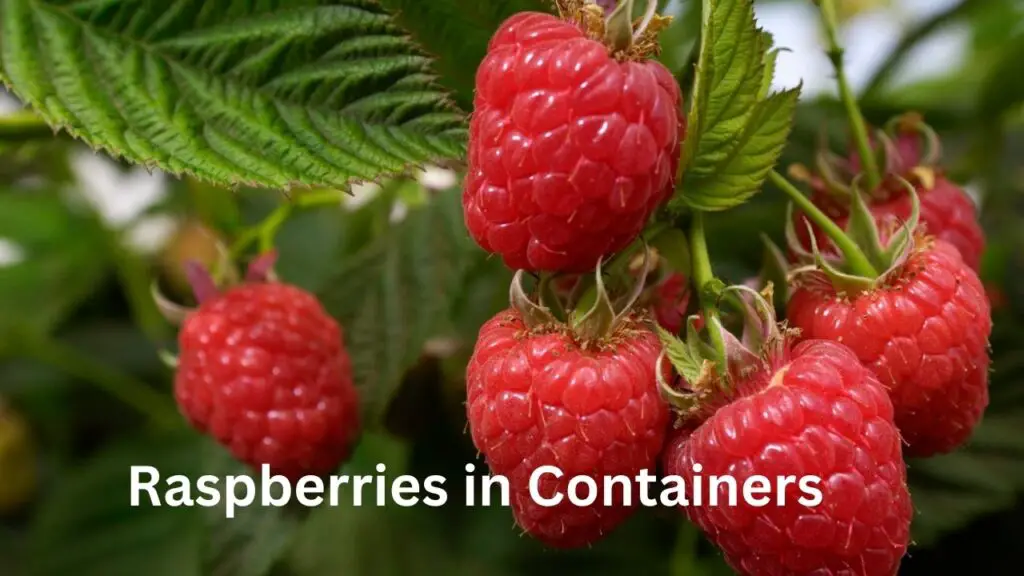
As a gardener, hydroponics expert, botanist, and agronomist, I am dedicated to helping gardening enthusiasts achieve success. In this article, I will provide you with scientifically backed information that will help you tackle a common problem in your garden: Troub.
Troub, also known as Trub, is a fungal disease that affects various plants, including fruits, vegetables, herbs, and flowers. It often manifests as dark, fuzzy growth on the leaves, stems, or fruits of affected plants. Troub thrives in warm and humid conditions, and it can quickly spread, leading to the decline and eventual death of your favorite garden specimens.
To effectively combat Troub, it is essential to understand its lifecycle and implement preventive measures. Regularly inspecting your plants and promptly removing any infected parts can help prevent the spread of Troub. Additionally, ensuring proper ventilation and avoiding overcrowding will create an unfavorable environment for the fungus to thrive.
Stay tuned for the rest of this article as we delve into specific strategies, such as natural fungicides and cultural practices, that can help you effectively manage Troub and maintain a healthy and thriving garden. Armed with scientific knowledge, practical tips, and a bit of dedication, you can overcome this challenge and achieve the garden of your dreams.
• Troub, also known as Trub, is a fungal disease that affects various plants.
• It manifests as dark, fuzzy growth on leaves, stems, or fruits of affected plants.
• Troub thrives in warm and humid conditions and can quickly spread.
• Regularly inspecting plants and removing infected parts can prevent the spread of Troub.
• Proper ventilation and avoiding overcrowding create an unfavorable environment for the fungus to thrive.
• In the rest of this article, we will discuss specific strategies like natural fungicides and cultural practices to manage Troub effectively.
• Armed with scientific knowledge, practical tips, and dedication, you can overcome this challenge in your garden.
Growing raspberries in containers:
Growing raspberries in containers can be a rewarding and space-saving way to enjoy these delicious berries, especially if you have limited garden space or poor soil quality. Here are some tips for successfully growing raspberries in containers:
- Container Selection:
- Choose large containers with a minimum depth of 18 inches and a diameter of at least 24 inches. This ensures there is enough space for the roots to grow and the plant to thrive.
- Soil:
- Use a well-draining potting mix with a pH between 5.6 and 6.2. Raspberries prefer slightly acidic to neutral soil.
- Variety Selection:
- Opt for dwarf or compact raspberry varieties suitable for container gardening. Some popular container-friendly varieties include ‘Heritage’ and ‘Raspberry Shortcake.’
- Sunlight:
- Raspberries thrive in full sunlight. Place your containers in a location that receives at least 6-8 hours of direct sunlight each day.
- Watering:
- Container plants typically require more frequent watering than those in the ground. Keep the soil consistently moist but not waterlogged. Use a saucer under the container to catch excess water and prevent root rot.
- Fertilization:
- Use a balanced, slow-release fertilizer when planting, and follow up with additional feedings during the growing season. Be mindful not to over-fertilize, as this can lead to excessive vegetative growth at the expense of fruit production.
- Support:
- Raspberries often benefit from support structures, even in containers. Use stakes or a trellis to keep the plants upright and help manage their growth.
- Pruning:
- Regular pruning is essential for raspberries. Prune out old canes that have already fruited and encourage the growth of new ones. This helps maintain the plant’s vigor and ensures a continuous harvest.
- Mulching:
- Apply a layer of organic mulch, such as straw or wood chips, around the base of the plants. Mulching helps retain moisture, suppress weeds, and regulate soil temperature.
- Pest and Disease Management:
- Keep an eye out for pests and diseases. Aphids, spider mites, and raspberry beetles are common pests, while diseases like powdery mildew and anthracnose can affect raspberries. Treat any issues promptly with appropriate organic or chemical controls.
- Winter Protection:
- If you experience harsh winters, move the containers to a sheltered location or insulate them to protect the plants from freezing temperatures.
Cultivating Sweet Success: A Guide to Growing Raspberries in Containers
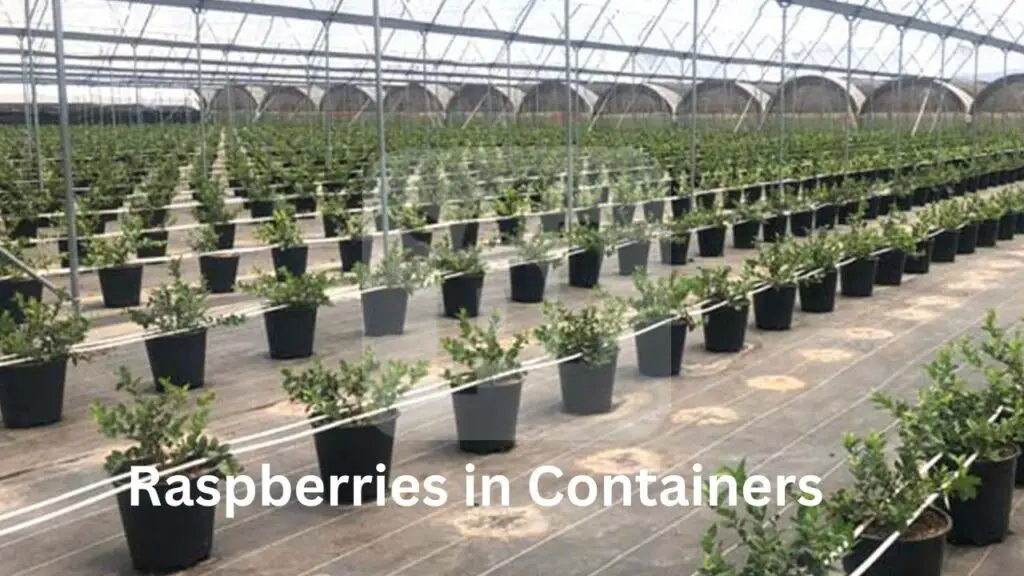
Raspberries, with their vibrant red hues and sweet-tart flavor, are a delight to any gardener and fruit enthusiast. While traditional raspberry bushes often sprawl across gardens, the advent of container gardening has opened up new possibilities for cultivating these delectable berries in smaller spaces. In this guide, we’ll explore the art and science of growing raspberries in containers, allowing even those with limited outdoor space to enjoy a fruitful harvest.
Container Selection:
The key to successfully growing raspberries in containers lies in selecting the right container. Opt for large pots with a minimum depth of 18 inches and a diameter of at least 24 inches. This ample space ensures that the raspberry roots have enough room to spread and that the plant can develop a robust root system.
Soil Preparation:
Choose a well-draining potting mix with a slightly acidic to neutral pH (around 5.6 to 6.2). Raspberries prefer soil that retains moisture without becoming waterlogged. Mixing in organic matter, such as compost, can enhance soil fertility and structure.
Variety Selection:
When growing raspberries in containers, selecting the right variety is crucial. Look for dwarf or compact raspberry varieties bred specifically for container gardening. Varieties like ‘Heritage’ and ‘Raspberry Shortcake’ are well-suited for confined spaces and still yield delicious berries.
Sunlight Requirements:
Raspberries thrive in full sunlight. Select a sunny location for your containers, ensuring they receive at least 6-8 hours of direct sunlight daily. Adequate sunlight not only promotes fruiting but also contributes to the overall health of the plants.
Watering Practices:
Container plants generally require more frequent watering than those in the ground. Keep the soil consistently moist, but avoid waterlogging. Using a saucer under the container can catch excess water, preventing root rot. Regular monitoring of soil moisture is essential, especially during hot weather.
Fertilization:
Provide your container-grown raspberries with a balanced, slow-release fertilizer during planting. Throughout the growing season, supplement with additional feedings, being cautious not to over-fertilize, as this can lead to excessive vegetative growth.
Support Structures:
Raspberry plants benefit from support structures to keep them upright and manage their growth. Stake the plants or use a trellis system to prevent the canes from sprawling and enhance air circulation.
Pruning for Success:
Regular pruning is a critical aspect of raspberry care. Remove old canes that have already fruited to encourage the growth of new ones. Pruning not only maintains the plant’s vigor but also ensures a continuous and abundant harvest.
Mulching Magic:
Apply a layer of organic mulch, such as straw or wood chips, around the base of the raspberry plants. Mulch helps retain soil moisture, suppresses weeds, and regulates soil temperature, creating optimal conditions for raspberry growth.
Pest and Disease Management:
Keep a watchful eye for common raspberry pests like aphids, spider mites, and raspberry beetles. Additionally, be vigilant against diseases such as powdery mildew and anthracnose. Treat any issues promptly with appropriate controls to safeguard your raspberry crop.
Winter Considerations:
For gardeners in regions with harsh winters, it’s advisable to move containers to a sheltered location or insulate them to protect the plants from freezing temperatures.
Here’s a simple table outlining key aspects of growing raspberries in containers:
| Aspect | Details |
|---|---|
| Container Size | Minimum 18 inches depth, 24 inches diameter |
| Soil | Well-draining potting mix with a pH of 5.6-6.2 |
| Variety Selection | Compact or dwarf varieties (e.g., ‘Heritage,’ ‘Raspberry Shortcake’) |
| Sunlight | 6-8 hours of direct sunlight daily |
| Watering | Keep soil consistently moist, avoid waterlogging, use saucers |
| Fertilization | Balanced, slow-release fertilizer during planting, additional feedings during the growing season |
| Support Structures | Stakes or trellis to prevent canes from sprawling |
| Pruning | Regularly prune out old canes after fruiting to stimulate new growth |
| Mulching | Apply organic mulch for moisture retention, weed suppression, and soil temperature regulation |
| Pests | Monitor for aphids, spider mites, and raspberry beetles; use natural predators or insecticidal soap |
| Diseases | Watch for powdery mildew and anthracnose; apply fungicides preventively |
| Watering Issues | Regularly monitor soil moisture, adjust watering based on weather conditions |
| Soil pH Imbalance | Test soil pH regularly and amend as needed |
| Winter Protection | Move containers to a sheltered location or insulate during freezing temperatures |
This table provides a quick reference for the key considerations when growing raspberries in containers. Adjustments may be necessary based on specific varieties, local climate, and individual growing conditions.
Battling On Raspberries in Containers: Strategies for Overcoming Persistent Raspberry Diseases
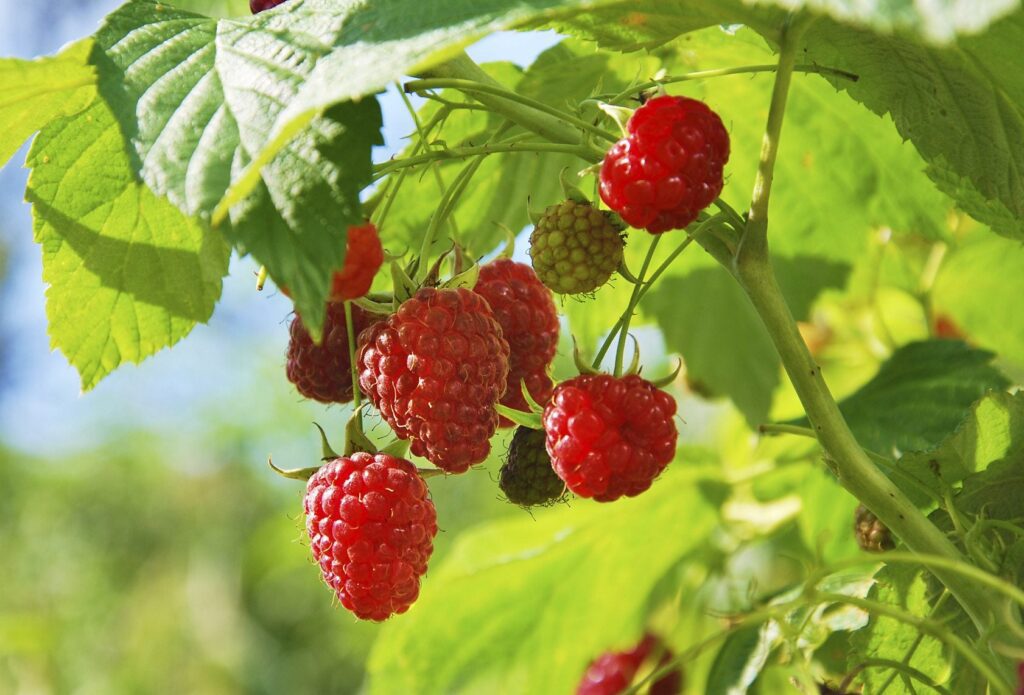
Raspberry enthusiasts know the joy of nurturing these sweet berries, but what happens when persistent troubles, or “Troub,” in the form of diseases threaten your raspberry patch despite your best efforts? In this article, we’ll explore practical strategies to tackle persistent raspberry diseases and regain control over your berry haven.
Identification and Diagnosis: Raspberries in Containers
Before implementing solutions, it’s crucial to accurately identify the specific diseases affecting your raspberry plants. Common raspberry diseases include anthracnose, powdery mildew, rust, and various viruses. Consult gardening resources or local experts to correctly diagnose the Troub at hand.
- Cultural Practices:
- Reassess your cultural practices. Ensure proper spacing between plants to promote air circulation, as this can deter the spread of diseases. Adequate sunlight and soil drainage are essential for overall plant health.
- Sanitation Measures:
- Practice good sanitation by promptly removing and destroying any infected plant material. This includes affected leaves, canes, and berries. Regularly clean your pruning tools to prevent the transmission of diseases.
- Fungicides and Disease-Resistant Varieties:
- Consider using fungicides labeled for raspberry diseases, following recommended application rates and schedules. Additionally, explore disease-resistant raspberry varieties, as these can be more resilient against certain pathogens.
- Crop Rotation:
- Implement a crop rotation strategy, avoiding planting raspberries in the same location for consecutive years. This helps disrupt the life cycle of soil-borne diseases and reduces the likelihood of infection.
- Soil Testing and Amendments:
- Conduct soil tests to assess nutrient levels and pH. Optimal soil conditions contribute to plant vigor and resilience. Based on the results, amend the soil with organic matter or specific nutrients as needed.
- Natural Predators and Beneficial Insects:
- Encourage the presence of natural predators and beneficial insects in your garden. Ladybugs, predatory mites, and parasitic wasps can help control pest populations that may contribute to the spread of diseases.
- Virus Management:
- If viruses are the Troub, focus on managing vector insects. Control aphids, which can transmit viruses, through insecticidal soaps or neem oil. Remove and destroy infected plants promptly to prevent further spread.
- Professional Consultation:
- If Troub persists, consider seeking advice from a local horticulturist, extension service, or plant clinic. These professionals can provide specific insights into your region’s challenges and offer tailored solutions.
- Resilience and Persistence:
- Successfully overcoming persistent raspberry diseases often requires a combination of strategies and persistence. Stay committed to your Raspberry patch, monitor changes, and be prepared to adapt your approach based on ongoing observations.
Sowing Sweet Success: Growing Raspberries in Containers and Troubleshooting Tips
Raspberries, with their burst of flavor and vibrant color, are a delectable addition to any garden. For those with limited space or less-than-ideal soil conditions, growing raspberries in containers presents a fruitful solution. This guide not only explores the nuances of successfully cultivating raspberries in containers but also addresses common challenges or “Troubs” that growers might encounter along the way.
Here’s a table outlining various raspberry diseases and their corresponding control measures:
| Disease | Symptoms | Control Measures |
|---|---|---|
| Anthracnose | Dark lesions on canes and fruit, can lead to dieback | Prune infected canes, apply fungicides labeled for anthracnose. |
| Powdery Mildew | White powdery spots on leaves | Provide proper spacing for air circulation, apply fungicides. |
| Root Rot | Wilting, yellowing, and stunted growth | Improve soil drainage, avoid overwatering, use well-draining soil. |
| Crown Gall | Swellings or galls on stems and roots | Remove infected plants, practice crop rotation, maintain soil health. |
| Rust | Orange pustules on leaves and stems | Remove infected leaves, apply fungicides, promote good air circulation. |
| Yellow Rust | Yellow spots on leaves, leading to defoliation | Remove and destroy infected leaves, apply fungicides, prune for air circulation. |
| Cane Blight | Dark purple lesions on canes, wilting | Prune infected canes, practice good sanitation, apply fungicides. |
| Virus Diseases | Yellowing, mosaic patterns on leaves | Remove and destroy infected plants, control aphid vectors, plant disease-resistant varieties. |
Note: It’s crucial to accurately diagnose the specific disease affecting your raspberries before implementing control measures. Integrated pest management (IPM) practices, such as regular monitoring, sanitation, and the use of disease-resistant varieties, are essential for effective disease control. Always follow recommended guidelines and use fungicides or treatments approved for raspberries
Container Cultivation Basics:

- Container Selection:
- Choose containers with a minimum depth of 18 inches and a diameter of at least 24 inches to provide ample space for the raspberry roots to spread.
- Soil Preparation:
- Opt for well-draining potting mix with a slightly acidic to neutral pH. Enhance the soil with organic matter to promote fertility.
- Variety Selection:
- Pick compact or dwarf raspberry varieties suitable for container gardening. Varieties like ‘Heritage’ and ‘Raspberry Shortcake’ are designed for confined spaces.
- Sunlight Requirements:
- Place containers in a sunny location, ensuring the raspberry plants receive 6-8 hours of direct sunlight daily.
- Watering Practices:
- Keep the soil consistently moist, but avoid waterlogging. Employ saucers under containers to catch excess water and prevent root rot.
- Fertilization:
- Use a balanced, slow-release fertilizer during planting and supplement with feedings throughout the growing season. Be cautious not to over-fertilize.
- Support Structures:
- Stake or use a trellis system to support raspberry canes and prevent sprawling.
- Pruning Techniques:
- Regularly prune out old canes that have fruited to stimulate new growth and maintain plant vigor.
- Mulching Magic:
- Apply organic mulch around the base of plants to retain moisture, suppress weeds, and regulate soil temperature.
Common Troubs and Solutions:
- Pests:
- Troub: Aphids, spider mites, and raspberry beetles.
- Solution: Regularly inspect plants for pests. Introduce natural predators or use insecticidal soap if infestations occur.
- Diseases:
- Troub: Powdery mildew, anthracnose.
- Solution: Apply fungicides as a preventive measure and ensure proper spacing for adequate air circulation.
- Watering Issues:
- Troub: Overwatering or underwatering.
- Solution: Monitor soil moisture consistently. Adjust watering frequency based on weather conditions.
- Soil pH Imbalance:
- Troub: Soil too acidic or too alkaline.
- Solution: Regularly test soil pH and amend as needed to maintain the optimal range for raspberries.
- Winter Protection:
- Troub: Freezing temperatures.
- Solution: Move containers to a sheltered location or insulate them to protect plants during winter.
What is Troub?
Troub is a term used to describe a problem or difficulty.
How can Troub be resolved?
Resolving Troub depends on the specific issue at hand. It may require troubleshooting, problem-solving, or seeking assistance from experts or professionals.
Are there common causes for Troub?
Yes, Troub can be caused by various factors such as technical glitches, lack of knowledge or skill, insufficient resources, or external circumstances beyond control.
Can Troub be prevented?
While it may not be possible to prevent all Troub, certain measures can be taken to minimize the occurrence. This includes regular maintenance, keeping systems up to date, gaining knowledge and skills, and having contingency plans in place.
What should I do if Troub persists despite my efforts?
If Troub persists despite your best efforts, it is advisable to seek the assistance of experts or professionals who specialize in the specific area related to the Troub. They may have additional insights or solutions that can help resolve the issue.
Is Troub a common occurrence?
Yes, Troub is a common occurrence in various aspects of life, including technology, business, and personal situations. It is a natural part of problem-solving and growth.
Can Troub have positive outcomes?
Yes, Troub can lead to positive outcomes. It can serve as a learning experience, helping individuals and organizations identify areas of improvement and develop strategies to overcome challenges.
How can I develop troubleshooting skills to handle Troub effectively?
Developing troubleshooting skills requires practice, experience, and a systematic approach. It involves understanding the problem, gathering relevant information, analyzing possible causes, and applying logical steps to identify and implement solutions.
Are there any tools or resources available to assist with Troub?
Yes, there are various tools and resources available to assist with Troub. These can include online forums, troubleshooting guides, diagnostic software, and support from customer service or technical teams.
Can Troub affect productivity or success?
Yes, if not addressed promptly, Troub can have a negative impact on productivity and success. It may lead to delays, errors, or inefficiencies that hinder progress. Therefore, it is important to address Troub effectively to minimize its impact.

